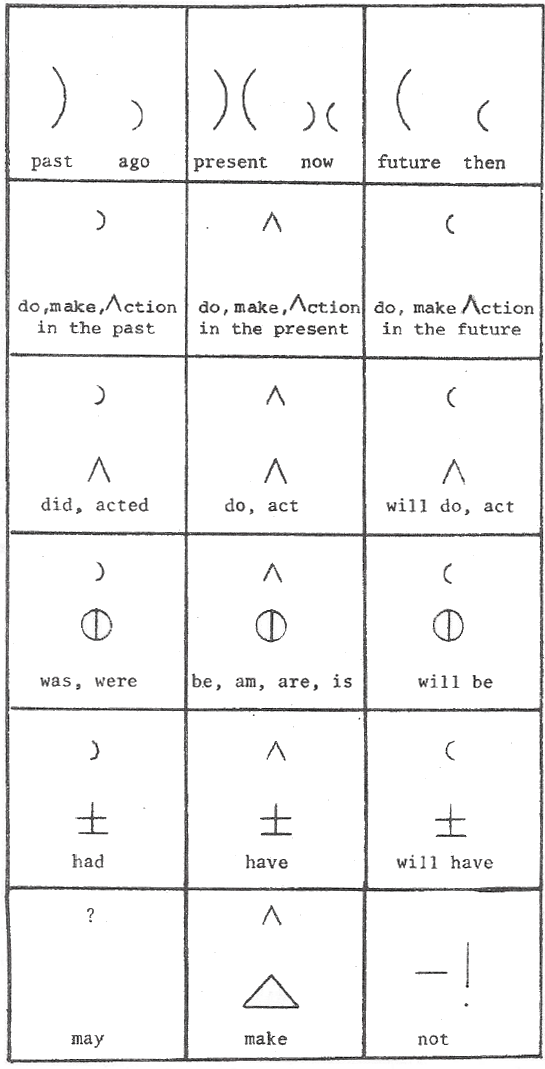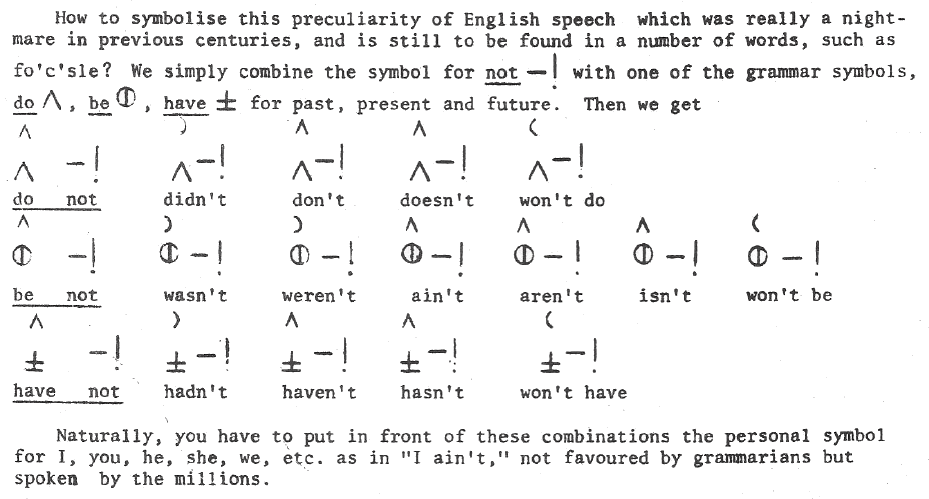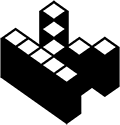
SUNDAY, FEB 28, 2016

The Grammar of Bliss
Bliss elements of style
Eric Lee, A-SOCIATED PRESS
TOPICS: CHARLES K. BLISS, SEMANTOGRAPHY, BLISSMBOLICS, LOGICAL LANGUAGE
TUCSON (A-P) — The Bliss language attempts to map "what-is" into a written language.
What-is:
- Matter
- Energy
- Valuation.
In Bliss there are no nouns, pronouns, adjectives, verbs, adverbs,... no pluperfect past conditionals. While Bliss has a speakable/typeable form, it is not a phonetic language. There literally are no parts of speech in it. There are parts of ideas and ideograms, however. Some natural language words can be associated with a Bliss ideograph, but Bliss grammar differs.
Matter 
The square indicator means "thing, physical/chemical perceptual entity, something demonstrably real and experientially shareable" as preceived or measured. Ideas may be nouns, but they are not things. Real things that are out there, independent of our minds, do things, they can act.
Action 
For every action there may be an equal and opposite reaction, but with equal certainty energy and action go together. Things can and do act, but it takes energy. Ideograms for action are indicated, if necessary, by the ^ indicator.
Valuation 
Language involves minds making eValuations and does not exist independently of the human mind/brain as evidenced by the stoppage of our mouths after death and dropping of the pen. The mind, from protists on, evaluates the what-is. Eatable? Engulf it. Danger? Go away from it. Sunny? Grow towards it. Plant tropisms have a chemical basis, but so do brains with a bit more electricity added. Organisms, especially humans, evaluate incessantly. Humans parse what-is into many parts and develop conceptual representations of them, whether right or wrong.
Diagrammatic language, like mathematics, Feynman diagrams, Odum diagrams, and Bliss help the human mind to create better representations of what-is. By nature, our collective grasp of reality is fragile. "Often-wrong" is our middle name. We need all the help we can get.
Natural language falls short of being the "algebra of thought" some can envision. If some humans do manage to think well, perhaps it is in spite of, rather than because of, their natural language handicap. This is the Leibniz conjecture.
Naming things and actions, doing the noun/verb thing, is problematic for human (often-wrong) animals. Our evaluations can be all over the map or any map we try to construct. If you say, "red" there is a good chance everyone in earshot will reference a different shade of red than you are. It may or may not matter. If you write "F00" and a reader in Mongolia has no idea what you mean, they could get a definite answer, down to the 620 nm one. And if what you meant was F04, then you could write what you mean. If you say "my face is F00" you are evaluating the likely state of your face and likely speaking metaphorically. To so indicate, an evaluatory indicator could be put above F00. If you say, "He was happy to do it." you are evaluating someones mental state when doing something and so the evaluation indicator goes above "happy" in Bliss. The evaluation indicator emphasizes that you attribute the happiness to someone who may be your empolyee, which is subject to doubt. Say, "life, liberty, fraternity" and communicating clearly may take some doing, beginning with you clarifying your claims in your mind before writing them down.
Indicators 
Indicators are a Bliss part of "speech" as written. So, Matter, Energy, Valuation, and Indicators to indicate existence, action, evaluation, past, future, active, passive, plural, person, possessive case and maybe a few others conditions. A few indicators are used within main ideograms, mainly pointers to point to specific parts. An example from C.K. Bliss:

Grammar Block

Particles
The particles are the connecting words and filler words common in natural language that don't fit neatly into the above. If you say them, you write them even if you don't know why or what to call them, sometimes just as embellishments of natural language. "Of the on an either way." In Bliss, bits that carry no real meaning are omitted. Particles are there to use or not as a writer deems necessary. Parsing speech into common nouns, proper, nouns, pronouns, adjectives, adverbs, prepositions, conjunctions, articles, determiners, and interjections is phun, but Bliss keeps it down to material things, actions, mind evaluations, indicators, and whatever you want to call what's left.
Filler Words
In natural language speaking filler words are required. It doesn't matter why humans say: y'know, I mean, like, well, uh, basically, ah, you see, um, actually..... No need to write in Bliss, but [@] or [@@] could be used for no reason.
Connecting Words
Connecting words do carry meaning and are useful. Conjunctions include for, and, nor, but, or, yet, so. Conjunctions correlate: both/and, either/or, neither/nor, not only/but also. Conjunctions introduce thoughts: although, after, before, because, how, if, once, since, so that, until, unless, when, while, where, whether.
Some words "show a relationship between a noun (or pronoun) and other words in a sentence." But Bliss is idea-based, so the relationships are between concepts: up, over, against, by, for, into, close to, out of, apart from, aboard, about, above, across, after, against, along, amid, among, around, as, at, atop, before, behind, below, beneath, beside, between, beyond, by, despite, down, during, for, from, in, inside, like, near, of, off, on, onto, out, outside, over, past, regarding, round, since, than, through, throughout, till, to, toward, under, unlike, until, up, upon, with, within, without. Typically natural languages have more words than concepts that come and go in usage. Bliss has little need for fashion statements.
Concept Particles
• Color: black, red, yellow, green, cyan, blue, fuchsia, white.
• Direction: through, around, open, close.
• Quantity: one, one more, less, more, most, few, many, some.
• Sequence: first, next, after that, and finally, before, after.
• Shape: circle, triangle, square, rectangle, diamond, oval, round.
• Size: small, large, big, little, huge, tiny.
• Feeling: happy, sad, mad, angry, silly, surprised.
• Texture: bumpy, rough, smooth, soft, prickly, hard.
• Time: morning, afternoon, evening, late, early, today, tomorrow, week, month, year, day.
• Spacial: on, off, in, out, under, in front, behind, top, bottom, up, down, inside, outside, high, low.
• Opposites:
In/Out, Big/Little, Up/Down, Happy/Sad, On/Off, Top/Bottom, First/Last, Open/Closed, Loud/Soft, Noisy/Quiet, Hot/Cold, Fast/Slow, Before/After, Hard/Soft, New/Old, Empty/Full, Behind/In Front, Outside/Inside, Asleep/Awake
Bliss is best taught and learned in the order concepts form in the human mind. Start with basics such as brain development allows the concieving of them.
Ages 1-2
Follows simple commands using spatial terms in or on.
Uses a few spatial terms such as in or on.
Uses simple directional terms such as up or down.
Ages 2-3
Understands number concepts such as 1 or 2.
Understanding of spatial terms become mastered with in, on, off, under, out.
Begins to understand same/different.
Time concepts begin to emerge, specifically with soon, later, wait.
Begins to use color and size vocabulary.
Ages 3-4
Advances spatial terms to understanding next to, besides, between.
Uses spatial terms behind, in front, around.
Begins to follow quantity directions such as a lot and empty.
Identifies colors.
Identifies what is different.
Ages 4-5
Understands comparing concepts such as big, bigger, biggest.
Advances time concepts to days of the week, yesterday, today, tomorrow, next week.
Understands sequence terms such as first, then, next and first, middle, last.
Understands the following concepts different, near, through, thin, whole.
Ages 5-6
Understands opposites such as big/little, over/under.
Understands right/left.
Understands number concepts through 20.
Can describe how things are same and different.
Use conceptual terms to describe things.


